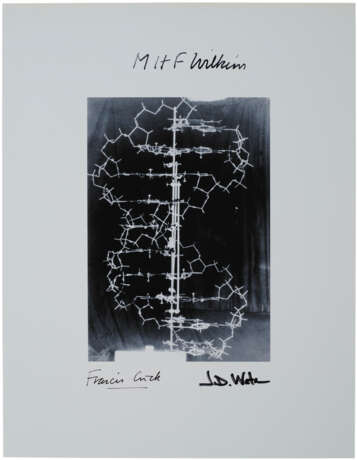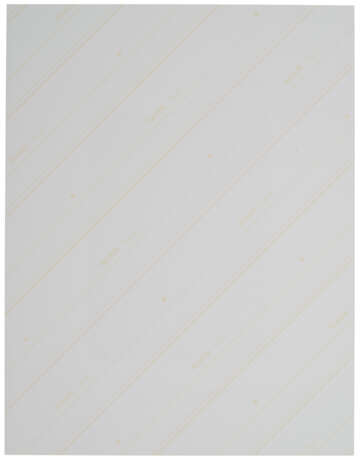ID 1279156
Lot 15 | THE DOUBLE HELIX OF DNA
Estimate value
$ 3 000 – 5 000
SIGNED BY CRICK, WATSON, AND WILKINS
Digital print signed in ink by Francis Crick, 1916-2004 ("Francis Crick") and James Watson, b.1928 ("J.D. Watson") on the lower margin and by Maurice Wilkins, 1916-2004 ("MHF Wilkins") on the upper margin.
Photograph of the original double-helix model of DNA, signed by all three Nobel Prize recipients for the discovery.
The 1953 discovery of the structure of DNA is among the most important single breakthroughs in the history of the life sciences. Based on x-ray diffraction images provided by Maurice Wilkins and Rosalind Franklin, James Watson and Francis Crick correctly interpreted the structure of DNA as a double helix. They then explained the implications of their discovery for unraveling one of the deepest mysteries of life – the means by which organisms reproduce themselves.
"The structure, as simple and elegant as it is profound, shows that two long strands of DNA run in opposite directions and spiral around one another in the shape of a double helix. Another vital element in the structure is that four organic bases – known as adenine, thymine, cytosine and guanine – are paired in a specific manner between the two helices in such a way as to provide a natural scaffold for the two strands. Watson and Crick’s structure of DNA could also explain how information is transferred in living material. The specific base pairing facilitates the perfect copying facility for heredity, while the specific order of bases forms the blueprint for the sequence of amino acids in a protein." (Pietzch, "Deciphering Life’s Enigma Code," NobelPrize.org.) The Nobel Prize in Medicine was awarded for this discovery in 1962. From genetic diagnoses to genomic vaccines, it is now almost impossible to imagine medical treatment without an understanding of DNA.
The model depicted in this photograph is the six-foot tall original made by Crick and Watson in 1953, which has since been dismantled and dispersed. Crick, Watson and Wilkins worked in three separate labs on two sides of the Atlantic, and items signed by all three men are rare. An original of this photograph is in the archives of Cold Spring Harbor Laboratory and it seems likely that the signatures were obtained by someone associated with the CSHL Symposia on Quantitative Biology. It was at this symposium in 1953 that the 26-year old Watson made the first presentation of the DNA double helix at an open meeting.
10 ¾ x 8 ½ in. (27.3 x 21.6 cm.)
| Auction house category: | Letters, documents and manuscripts, Medicine & science, Books and manuscripts |
|---|
| Auction house category: | Letters, documents and manuscripts, Medicine & science, Books and manuscripts |
|---|
| Address of auction |
CHRISTIE'S 8 King Street, St. James's SW1Y 6QT London United Kingdom | |
|---|---|---|
| Preview |
| |
| Phone | +44 (0)20 7839 9060 | |
| Buyer Premium | see on Website | |
| Conditions of purchase | Conditions of purchase |




